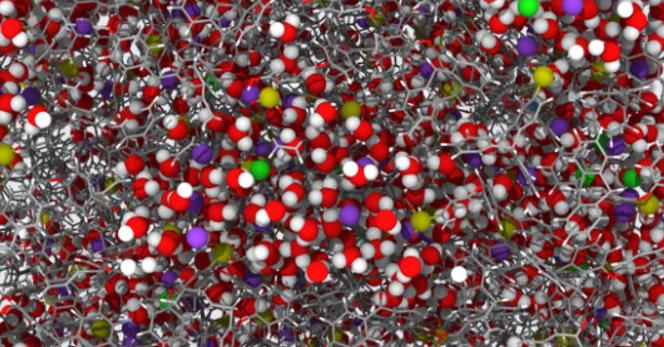Battery technology thread
"The cathode is not made from the familiar mixture of #lithium and other metals. Instead, the primary ingredient is #zinc, which ranks as the fourth most produced metal in the world.
Eos’s batteries use a #water-based electrolyte (the liquid that moves charge around in a battery) instead of organic solvent."
This is intended to be a #GridBattery.
#EnergyStorage
https://www.technologyreview.com/2023/09/06/1079123/zinc-batteries-boost-eos/
"#Vanadium #FlowBatteries may be more expensive up front but last for decades, don’t catch fire and can store and dispatch sunshine for 10 to 18 hours
Coupling a six megawatt solar plant with an eight MWh flow battery at the site will produce 10 GWh of dispatchable solar power yearly.
Australia has vast reserves of vanadium but most of the world’s supply is sourced from China, Russia and South Africa and goes into making steel alloy."
"#Battery giants are starting to put their money on new #sodium-based technology, a sign that there could be yet another shakeup in the industry that’s crucial for the #EnergyTransition.
Even with the recent slump in lithium prices, sodium is still a cheaper option.
Its clearest potential advantage is in storing excess electricity for grids."
Not all #batteries work on chemistry.
"When wind or solar power is abundant, the energy can be used to compress carbon dioxide gas into a liquid. When extra energy is needed, the liquid will be allowed to decompress, turning back into gas and powering a turbine to generate enough electricity to power up to 20,000 homes. "
“Right now we have nothing that can buffer a 4 megawatt solar field.”
Dendrite formation is the bane of lithium batteries.
"In the new research, Li and his team stop #dendrites from forming by using micron-sized silicon particles in the anode to constrict the lithiation reaction and facilitate homogeneous plating of a thick layer of #lithium metal."
#batteries
https://www.pv-magazine.com/2024/01/15/new-solid-state-battery-charges-in-minutes-lasts-for-thousands-of-cycles/
"The recent price cuts come from a deliberate decision to use abundant earth materials such as iron and phosphorus wherever possible.
These #batteries are cheaper, as they have no #cobalt. They have other benefits too: a longer usable life and less risk of fire than traditional #lithium battery chemistries. The downside is they have lower capacity and voltage."
" The facility will be located in Edgecombe County, NC, and is expected to produce 24GW of #Natron’s revolutionary #sodium-ion batteries annually at full capacity. Natron’s #sodium-ion batteries offer higher power density, more cycles, a domestic U.S. supply chain, and unique safety characteristics over other battery technologies. "
"Ambitious young EV automaker #ZEEKR is claiming a “new charging speed record” using its latest model and new lithium-iron-phosphate (LFP) #batteries, unveiled during a Tech Day event in China today. ZEEKR states that its new batteries can recharge its EVs from 10-80% state-of-charge as quickly as 10.5 minutes. "
https://electrek.co/2024/08/13/zeekr-announces-new-lfp-batteries-recharge-ev-10-80-minutes/
Would be nice to have some data on power density and longevity, but it's early days.
Lithium iron phosphate (LiFePO4) , or LFP batteries:
– do not contain nickel, manganese, or cobalt;
– cost significantly less, $60 per kilowatt-hour;
– can handle more charge-discharge cycles;
– have short charging times.
However, they have:
– less range (per kg);
– poor cold-weather performance
No data yet on safety performance.
The world’s first 100% silicon anode #battery will be manufactured from 2027 and will offer future EVs a 186-mile range with just five minutes of charging time.
https://www.livescience.com/technology/electric-vehicles/worlds-1st-silicon-anode-ev-battery-will-let-you-drive-up-to-186-miles-after-just-5-minutes-of-charging
#SiliconBattery
"A multi-institutional team based at Imperial College in London and the Dalian Institute of Chemical Physics in China has been developing a new membrane for #FlowBatteries that deploy alternative electrolytes such as aqueous organic or zinc-iron formulas, which have the potential to combine low toxicity with high energy density and a long lifecycle."
https://cleantechnica.com/2024/12/26/new-flow-battery-membrane-aims-to-kill-natural-gas-not-just-coal/
#sPEEK

@CelloMomOnCars grid storage is a big deal. You want to optimize for price per kilowatt hour, not kg or L. Nice to see this.
Yes, finally, FINALLY there is battery innovation, and lots of it.
Lithium is really too much "one size fits all", we're past that era now; there are a lot of energy storage niches, and each should be filled by the most appropriate tech.
@CelloMomOnCars there is no one size fits all solution. Anyone who says they have one is full of shit
I wouldn't quite say “finally”, there's R&D out there on stuff other than lithium, but I'm sure Li gets the lion's share of the R&D
@CelloMomOnCars compressed CO2/ turbine. Be nice if it works. More energy storage options are good
@CelloMomOnCars curious what effect that has on cold-temperature charging/use, if any.
Good question!
It's early days for this research, and lots of real-world questions are yet to be answered.
@CelloMomOnCars Also, I see "faster charging" and I think that perhaps the people writing these articles have not thought about energy vs power and what power draw a rapid charge implies for the large batteries in the large cars we decided to put them in. Versus, for an e-bike battery, this would be fine. Also for an e-bike battery, can solve a lot of the temperature problems w/ a few resistors & a smarter controller; if someone tries a cold charge, just warm the battery first.
E-bike riders do have to take care of their batteries at these low temps (bring it inside, if you can, and let it warm up before starting to charge), as none of them afaik have the kind of software that keeps e-car batteries safe at low temps.
@CelloMomOnCars The lack of that software is so annoying, because it would relatively cheap compared to the cost of a battery.
@CelloMomOnCars I’ll have to read the source paper from Nature later. Reading the abstract, doesn’t sound like the thrust of the paper involves a solid electrolyte, despite the papers title.
The term “solid state” has been so bastardized with batteries as to become meaningless
@CelloMomOnCars There is a hell of a lot more accessible sodium all around than lithium. I always have trouble reconciling business sales BS with the science behind it. I'll have to look into this technology. Sounds interesting.
@CelloMomOnCars they are safer, much less likely to thermal runaway.
You would have less range for the same weight of LFP battery, but the price tag on your car would be much lower.
And if you can charge it under 10 minutes maybe one stop in the middle of the day, when you have to eat, or at least visit a toilet, would we workable.
@CelloMomOnCars This *sounds* great.
The company behind this is questionable. But they got Mercedes on board with them, so that’s encouraging.
@CelloMomOnCars Do they say anything about safety? If it packs in more energy than a Lithium battery then it will release more energy in a fire - and Lithium battery fires are causing major problems. How hard is it for it to short out a cell?
The safety issue is a good question (I don't know the answer but I'm sure it's out there).
The lithium battery fires I think are more about the chemistry than about the energy density, that's what makes it hard to extinguish.
@CelloMomOnCars @LillyHerself that's it! I'm putting all my money on [checks notes] sand.
Rule of thumb: Celebrate a new Battery, when it's available on the market.
@CelloMomOnCars
am I the only one to wonder why most of the advances in clean tech is coming from China and Europe.
I missr the days when the USA lead in innovation and education. The USA seems to be on a downward slide with a focus on wealth concentration, not wealth creation. Now all the new programs seem to be focused on sliding down as fast as possible before the common folks notice.
The USA will be run by convicted criminal, con-men and cronies.
#democracy is more than voting!
@mral @CelloMomOnCars Because America is under the thumb of fossil fuel barons????? Saudis, Ruschians?? C’mon.
@CelloMomOnCars
I know the quote is from the article, but argh.
Rechargeable batteries don't "produce" electricity. They "deliver" it. The electricity still has to be produced, grid batteries allow the delivery time to be shifted.
I get your frustration but this is about a facility producing batteries.
@CelloMomOnCars In that case the quote makes even less sense. 24GW is a measure of flow, not quantity. They probably mean 24GWH. (Remainder deleted because I am being a pre caffeinated dumbass.)
@CelloMomOnCars (Now i suspect that I'm going to go look at your profile and discover that you are an electrical engineer and I'm going to look like an idiot.)
If the factory annually makes a million batteries that each can hold 24kWh of energy that would be 24GWh annual fabrication output. But maybe they do mean enough battery to supply 24GW of juice, together. The latter would make more sense if the batteries will be used for utility scale storage, e.g. for frequency stabilisation.
(Physicist. So I do feel your frustration!)


